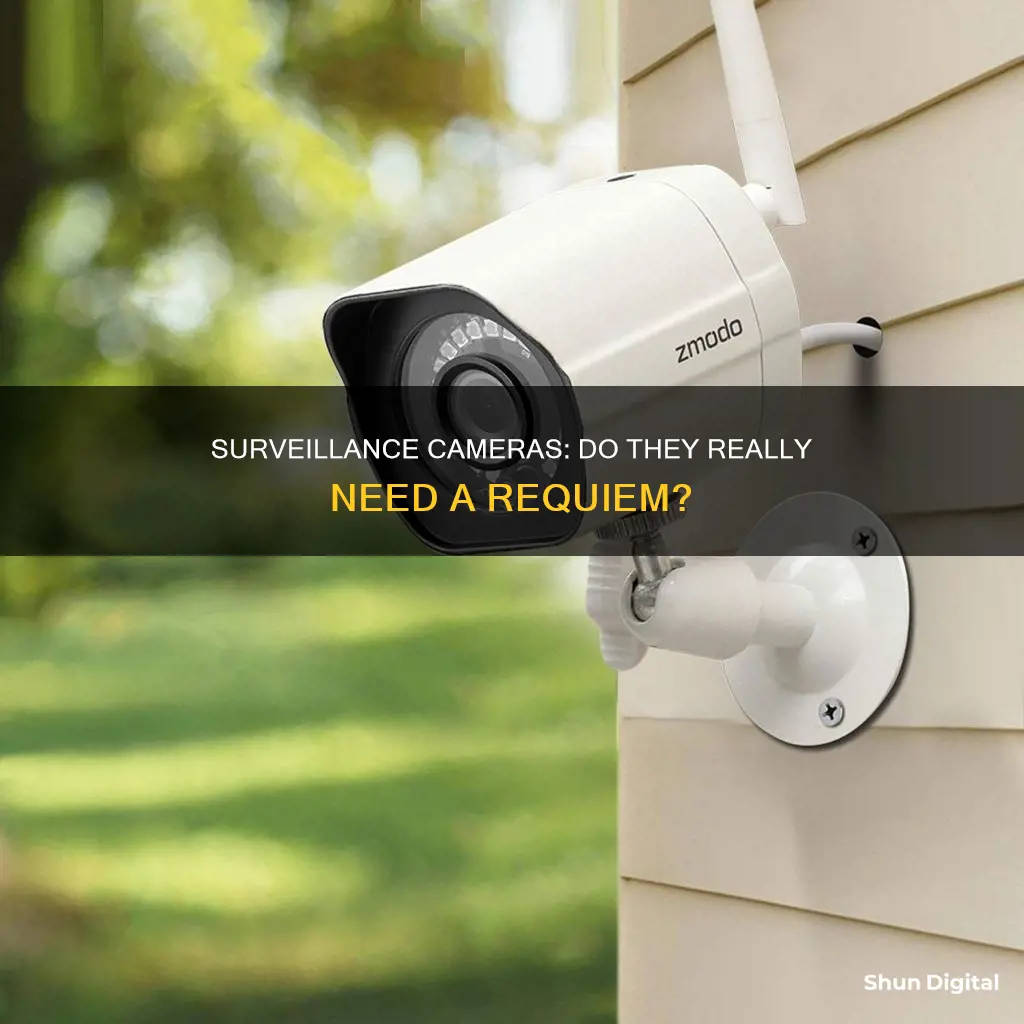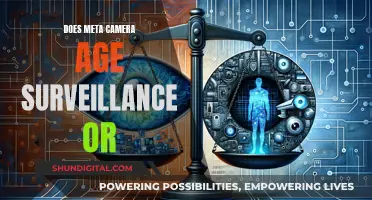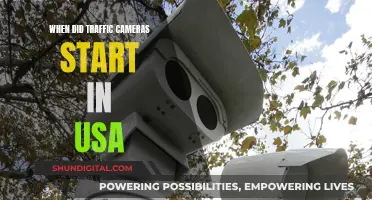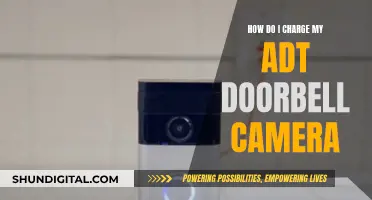
The use of surveillance cameras by law enforcement is a contentious issue, with some arguing that it invades privacy. The Fourth Amendment protects citizens against unreasonable searches and seizures, and courts have often been faced with the challenge of applying this amendment to new technologies. For instance, in 2012, the U.S. Supreme Court decided that a warrant is required to use a tracking device on a car, and in 2018, the Court ruled that a warrant is also necessary to access historical cell phone location data. Similarly, the ACLU and ACLU of Massachusetts filed a petition in 2024, urging the U.S. Supreme Court to clarify that police should obtain a search warrant before conducting long-term surveillance of a person's home with a hidden camera. This petition was sparked by a case in which federal agents surveilled a woman's home for eight uninterrupted months without a warrant.
| Characteristics | Values |
|---|---|
| Purpose | Monitoring of behaviour, activities, or information for the purpose of information gathering, influencing, managing, or directing |
| Locations | Outside, inside, workplaces, public spaces, private homes, transport, schools, shops, streets, public buildings |
| Privacy | No right to privacy in public places. No cameras in areas with a reasonable expectation of privacy (e.g. bathrooms, bedrooms, locker rooms, dressing rooms) |
| Legality | Varies by state and country. Generally allowed in public spaces without explicit consent |
| Audio Recording | Restricted by the Federal Wiretap Act. May be prohibited by state law |
| Video Recording | Generally allowed without consent |
| Camera Type | Commercial-grade, consumer-grade, IP, PTZ, multi-sensor, wireless |
| Camera Features | Night vision, motion detection, email alerts, facial recognition, thermal imaging, high-dynamic range, smart infrared |
| Storage | DVRs, network-attached storage devices, cloud storage |
| Benefits | Crime prevention, evidence collection, monitoring, safety, security |
What You'll Learn

Wired vs. Wireless
Surveillance cameras are available in wired and wireless variants, each with its own set of advantages and disadvantages. This discussion will focus on the differences between the two types in terms of installation, performance, reliability, cost, and other factors.
Installation
Wired security cameras require physical cables for network connection and power supply, necessitating more labour and complex installation. They often involve drilling holes, running cables through walls, and connecting to a central monitoring or recording unit. In contrast, wireless security cameras offer a more straightforward and flexible installation process without the hassle of cables. They connect to the network via Wi-Fi and are powered by batteries or electrical outlets.
Performance and Reliability
Wired cameras offer high-quality video and audio with no signal interference or loss, making them ideal for businesses and larger properties. Since they don't rely on Wi-Fi, they are less prone to interference and less vulnerable to hacking or cyber-attacks. Wireless cameras, on the other hand, may experience signal loss or interference due to distance or obstructions, making them more suitable for smaller spaces or homes. They rely on a stable Wi-Fi connection and are more susceptible to hacking if not properly secured.
Cost
The cost of installing a wired or wireless security camera system can vary depending on factors such as region and specific needs. Wired cameras typically have lower equipment costs but may require professional installation, increasing the overall expense. Wireless cameras may have higher equipment costs but generally have lower installation costs since they don't require extensive cabling.
Other Factors
Wired cameras are more challenging to conceal due to their wired connections, while wireless cameras offer greater flexibility in placement and repositioning. Wired cameras are better suited for permanent installations and areas with reliable power sources, while wireless cameras are ideal for temporary or remote locations where wiring is impractical. Wireless cameras also provide remote access and are easier to integrate with home automation systems.
Alabama Camera Tickets: What You Need to Pay
You may want to see also

Indoor vs. Outdoor
When it comes to indoor vs. outdoor surveillance cameras, there are several factors to consider. Here are some key points to help you decide which type of camera is more suitable for your needs:
Indoor Cameras:
- Indoor cameras are typically less expensive, with an average cost of around $100.
- They should be placed on the ground level of your home and in areas that are easily accessible, such as hallways or living rooms. Avoid installing cameras in private spaces like bathrooms or bedrooms due to privacy concerns.
- Most indoor cameras require a Wi-Fi or internet connection. However, there are a few exceptions, such as cameras that connect and record directly to a DVR or NVR.
- Indoor cameras are more likely to be plug-in cameras, as they may not have access to outdoor outlets.
Outdoor Cameras:
- Outdoor cameras tend to be more expensive, with an average cost of around $200. This is because they come with weather-resistant cases to withstand different temperatures and elements such as rain, snow, or dust.
- When determining the durability of an outdoor camera, consider its IP rating, which indicates how resistant it is to solids and liquids. For example, an IP rating of 65 means the camera is dust-tight and can withstand low-pressure water jets.
- Unlike indoor cameras, outdoor cameras are more likely to be wireless, as they may not have access to power outlets.
- Video doorbells are a type of outdoor camera specifically designed for front doors. They allow you to see and speak to guests remotely through a mobile application or smart home device.
In summary, both indoor and outdoor cameras have their advantages and considerations. Indoor cameras are generally more affordable and suitable for monitoring easily accessible areas inside your home. On the other hand, outdoor cameras are designed to withstand the elements and provide monitoring for exterior spaces, often utilizing wireless connectivity.
Fujifilm Instax Square SQ10: Hybrid Camera, Instant Battery Power
You may want to see also

Security vs. Surveillance
Security cameras, also known as CCTV cameras, are used to transmit signals from a specific area to a monitor located at a different spot. They are commonly found in retail stores, parking lots, office buildings, and other areas to monitor customer traffic and business operations. Security cameras are effective at keeping track of suspicious visitors and deterring criminal acts. They also provide valuable evidence in the event of a crime, with many now offering high-quality audio and video.
However, security cameras can be vulnerable to hacking and may compromise the privacy of staff in office environments. They are also expensive, with the most sophisticated systems costing several thousand dollars.
Surveillance cameras, on the other hand, work on an IP network that links the camera from a remote area and transfers the video to a security area. This allows for longer recording times, making it ideal for surveillance activities. Surveillance cameras are usually placed in public spaces and are informed by AI. They are typically used by law enforcement or security staff to detect and prevent criminal activity.
Surveillance cameras are often hidden from view, while security cameras are visible. Surveillance cameras are also more advanced in terms of technology; they can detect motion within a specific area and send alerts to operators. They can also identify objects in motion, such as people, animals, and vehicles.
Both security and surveillance cameras have their advantages and disadvantages, and both are used to protect specific areas. However, they differ in their applications, with security cameras designed to deter crime and surveillance cameras used to catch targeted individuals.
Cameras with Post-Focus: Capturing Moments with Creative Flexibility
You may want to see also

Public vs. Private
The use of surveillance cameras in public and private spaces has sparked a debate about security versus privacy. While some individuals feel more secure with the presence of cameras, others feel that their privacy is being invaded. This issue becomes more complex when considering the different regulations for video and audio recording, as well as varying laws across states and counties.
Public Surveillance Cameras
Public surveillance cameras are typically placed in streets, parks, parking lots, and buildings to monitor and record activities for security and safety purposes. They are often installed by law enforcement agencies, local governments, businesses, or private entities. There are no federal laws prohibiting the use of surveillance cameras in public spaces, and it is generally considered legal to record video in these areas. However, there are privacy concerns related to the use of cameras in public restrooms, changing rooms, and other places where individuals have a reasonable expectation of privacy.
Private Surveillance Cameras
The use of surveillance cameras on private property, such as residential homes, rented rooms, and hotel rooms, is generally allowed as long as it does not violate the reasonable expectation of privacy. For example, it is illegal to place hidden cameras in private spaces without the consent of the individuals being recorded. Consent laws vary by state, with some requiring the consent of all parties involved, while others only need the consent of one party.
Pros and Cons of Public Surveillance Cameras
Proponents of public surveillance cameras argue that they improve public safety, deter crimes, and aid in catching criminals by providing valuable evidence. Additionally, they can bring convenience to everyday life, such as monitoring road conditions and helping to prevent traffic violations. On the other hand, critics of public surveillance cameras raise concerns about privacy invasion, the high cost of implementation and maintenance, and potential abuses of the system. The effectiveness of these cameras in deterring crimes, especially those committed by individuals with suicidal intentions, is also questioned.
Understanding Camera Raw CS4: A Beginner's Guide
You may want to see also

Pros and Cons
Pros of Surveillance Cameras
- Deter crime: Security cameras can dissuade property damage and reduce crimes like trespassing and burglary.
- Monitor scenarios and activities: Surveillance cameras can help provide peace of mind when away from home or business by allowing remote check-ins.
- Gather evidence: High-quality video and audio recordings can be useful in legal scenarios and for insurance claims.
- Arrive at the right decisions: Footage from security cameras can help settle disputes and correct or fabricated claims.
- Maintain records: Security cameras can be used to keep a record of the goings-on in or around a business or home.
Cons of Surveillance Cameras
- Privacy is an issue: Surveillance cameras inevitably record everyone in their path, which can be an invasion of privacy.
- It can be costly: The implementation of security cameras can be expensive, especially for hardwired systems.
- They can be vulnerable: Security cameras are electronic devices that can be disabled by impact, water damage, or tampering.
- Can't stop theft: While security cameras deter thieves, they won't stop those who are determined to commit a crime.
- Make family and visitors uncomfortable: Surveillance cameras may raise privacy issues for family members and visitors.
- False sense of security: Simply having security cameras in place doesn't guarantee protection from crime or other issues.
- Security concerns: Improperly installed cameras can be hacked, and footage stored on local devices may be vulnerable to physical theft.
Mastering Manual Focus with Hikvision Cameras: A Step-by-Step Guide
You may want to see also
Frequently asked questions
Security cameras are often found in retail stores, office buildings, and parking lots, where they record footage to monitor public activity. Surveillance cameras, on the other hand, are strategically placed in public areas to identify and deter criminal conduct. They are integrated with AI and can be paired with smart devices to take immediate action.
Some pros of surveillance cameras include improved public safety, reduced crime rates, and the ability to catch criminals and gather evidence. However, there are also cons, such as the potential for abuse and misuse of surveillance footage, doubts about their effectiveness in deterring certain types of crimes (e.g., suicide bombers), and the high cost of implementation and maintenance.
There are wired and wireless surveillance cameras. Wired cameras are physically connected to an on-site video storage device and use DVR (Digital Video Recorder) or NVR (Network Video Recorder) technology. Wireless cameras, also known as IoT (Internet of Things) cameras, are more advanced and can be integrated with smart home systems. They rely on a strong Wi-Fi connection to function properly.







